Key Takeaways:
- Innovative Engineering & Design: The Luger P08 stands out for its revolutionary toggle-lock action, ergonomic grip, and precision-focused design. These engineering innovations distinguished it from contemporaries and influenced future firearm developments.
- Historical and Military Significance: Adopted by the German Navy and Army in the early 20th century, the Luger P08 served in both World Wars, making it iconic as a symbol of German military might. Its presence on the battlefield and in the hands of various nations solidified its place in firearms history.
- Enduring Collectibility and Cultural Impact: Valued for its rarity, variant types (e.g., Navy, Artillery, Krieghoff), and historical provenance, the Luger P08 remains a highly prized collector’s item. Its continued relevance in modern shooting sports and popular culture highlights its timeless appeal.
Let’s be honest—some guns fade into obscurity. The Luger P08? It carved out its own corner in history. This isn’t just a firearm; it’s an icon, a mechanical work of art, and a symbol of innovation that still sparks conversations over a century later.
From its distinctive toggle-lock action to its unmistakable silhouette, the Luger isn’t just admired—it’s studied, collected, and downright revered. But why does this old German pistol still hold such power over collectors, shooters, and history buffs alike? Let’s take a closer look.
Where It All Began: Georg Luger and His Vision
The tale starts with Georg Luger, an Austrian designer who had an eye for mechanical elegance. In the late 1890s, he took a good, hard look at the Borchardt C-93—a pistol that was innovative but, frankly, bulky and awkward—and thought, we can do better than this.
And he did.
The Luger he developed, officially designated the Parabellum Pistol, was leaner, smoother, and a whole lot more refined. What really made it stand out, though, was the toggle-lock mechanism—a design you simply don’t see in modern handguns. We’ll get into that more in a bit.
By 1898, Deutsche Waffen und Munitionsfabriken (DWM), a prominent German arms manufacturer, was already producing the Luger. Originally chambered in 7.65mm, it wasn’t long before the more powerful 9mm Parabellum became its soulmate cartridge.
Military Adoption: From Sidearm to Symbol
The Luger caught the eye of military brass almost immediately. The German Navy signed on in 1904, and by 1908, the Army made it official—hence the name P08.
And then came World War I. Suddenly, the Luger wasn’t just a clever design—it was everywhere. Trench officers carried it. Soldiers brought it home as trophies. It became a tangible piece of war.
By World War II, the Luger was still in action, even though it was technically being phased out in favor of the Walther P38. But that didn’t matter to collectors. Or to Allied troops, who frequently prized the Luger as the ultimate battlefield souvenir.
That Toggle-Lock Action: Why It’s Such a Big Deal
You’ve seen slides snap back and forth on most pistols. The Luger? It’s got something different going on.
The toggle-lock is a clever bit of engineering. When you fire, the barrel and toggle recoil together. Then, thanks to a cam inside the frame, the toggle snaps upward—almost like a hinge on a jackknife. This action ejects the spent casing and loads the next round.
It’s mesmerizing to watch and oddly satisfying to operate. More importantly, it works. Once you get the rhythm of it, it’s smooth and surprisingly reliable, especially considering the tech is over a century old.
Why do people love it so much?
- It’s mechanically fascinating.
- It dampens recoil better than you’d expect.
- And let’s be real—it just looks cool when it locks open.
There’s something inherently graceful about the movement, like the mechanical equivalent of a ballet dancer mid-spin. It might not be the simplest design ever, but it delivers something modern pistols often don’t: mechanical poetry.
9mm Parabellum: The Round That Changed the Game
The Luger P08 helped popularize a round that now dominates the pistol world—9mm Parabellum.
Georg Luger introduced this cartridge in 1902, and it turned out to be a perfect match for his new pistol. It had the right mix of stopping power, manageable recoil, and flat trajectory. Even today, most military and police forces around the globe rely on some variation of this round.
And yes, it’s often still called 9mm Luger. That’s how deep this gun’s influence runs—it literally gave its name to the ammo.
The Grip, The Feel, The Ergonomics
Let’s talk about how the Luger actually shoots. Because this thing wasn’t just designed to look good—it feels good, too.
One of the most talked-about features is the grip angle. It’s steeper than what you’ll find on a Glock or 1911, but here’s the twist: it points naturally. Raise it up, and your sights are just… there. No awkward wrist contortions required.
It’s a well-balanced pistol, weighing in at just over 2 pounds, with a center of gravity that makes it feel lighter in hand than the number suggests.
Trigger pull? It’s crisp, with just enough take-up and a clean break—no gritty nonsense. And while the iron sights aren’t what you’d call “high-vis,” they’re precise enough for target shooting or close-quarters defense.
For a pistol designed in the 19th century, it’s shockingly modern in how it handles.
Collector Gold: Why Lugers Are So Coveted
Here’s where things get spicy—Luger collecting is a deep, fascinating rabbit hole. You can spend a lifetime learning the differences between manufacturers, year ranges, and variant types.
So what makes a Luger valuable?
- Original parts and matching serial numbers are king.
- Maker matters—Mauser and DWM are common, but a Krieghoff? That’s unicorn territory.
- Historical context—A Luger carried in WWI trenches or used by a German naval officer carries more cachet than a post-war reissue.
- Condition—Of course. Finish wear, grip condition, bore quality… it all counts.
- And let’s not forget accessories: holsters, matching magazines, and especially capture papers can boost a pistol’s value significantly.
Lugers aren’t just bought—they’re curated.
A Few Standout Variants (for the Nerds Among Us)
Once you catch the bug, you start chasing specific models. And the Luger P08 line doesn’t disappoint in that department.
- Navy Lugers have longer barrels (6 inches or more) and adjustable sights. Scarce and beautiful.
- Artillery Lugers? Even longer barrels (often 8”), tangent sights, and sometimes a detachable wooden stock. These were intended for—no surprise—German artillery troops.
- Krieghoff Lugers are the holy grail for many collectors. Produced in limited quantities for the Luftwaffe, they’re as rare as they are expensive.
Each variation has its own story, quirks, and appeal. Some were issued to officers. Others were special contracts. And many have the kind of wear that tells a real story—something that makes them feel alive.
In Pop Culture: The Villain’s Favorite Sidearm
Let’s be honest—you’ve seen the Luger before, probably in black-and-white war films or in the hands of a sneering villain in a spy thriller.
Hollywood loves the Luger for one big reason: it’s instantly recognizable. That curving grip, the toggle-lock, the long thin barrel—it just screams “classic European firearm.”
From Indiana Jones to Band of Brothers, the Luger has been cast as both a tool of evil and a symbol of resistance. Either way, its screen presence is undeniable.
Still Shooting? You Bet.
You might think a gun that saw heavy use over 100 years ago wouldn’t hold up on the range—but you’d be wrong.
Plenty of collectors and shooters still fire their Lugers today. The key? Proper maintenance. And maybe a bit of mechanical patience.
The toggle-lock system does require some finesse, and the magazines (especially originals) can be finicky. But when everything is working as it should? It’s a smooth, satisfying shooting experience that’s unlike anything else.
Some folks even compete with them in military surplus matches, showing that the old warhorse still has some fight left in it.
For Beginners: Owning and Maintaining a Luger
If you’re lucky enough to pick up a Luger—maybe you inherited one or scored a deal—it helps to know the basics of maintenance.
Here’s a quick breakdown:
- Safety first. Always check to make sure the gun is unloaded before handling or disassembling it.
- No tools required. That’s right—Georg Luger designed it to be field-stripped without a screwdriver.
- Disassembly tip: Retract the toggle, remove the side plate, and then the barrel and upper receiver slide off as a unit. It takes practice, but it’s oddly satisfying once you get the hang of it.
- Clean carefully. Pay close attention to the toggle assembly and chamber area.
- Reassembly: This can feel like solving a tiny mechanical puzzle. Just go slow, and don’t force anything.
Once you’ve cleaned it a few times, you start to understand how everything fits together—literally and metaphorically. It’s a firearm that teaches you patience and respect.
Why the Luger Still Matters
So why does the Luger P08 still capture imaginations? It’s not just the mechanical design. Or the historical significance. Or even the collectible value.
It’s all of that—plus the stories it carries.
Each Luger has a past. Some were dragged through trenches. Others saw quiet peacetime service. A few sat in desk drawers for decades, waiting for someone to notice the elegant German markings and wonder, What’s the story here?
And maybe that’s the Luger’s greatest strength—it doesn’t just shoot bullets. It fires up curiosity.
Final Thoughts
The Luger P08 isn’t just another old pistol. It’s a piece of history that still speaks, whether from behind museum glass, the auction floor, or the firing line.
For enthusiasts, it’s a gateway to an era when precision engineering was personal. For historians, it’s a relic that connects stories across continents and decades. And for shooters? It’s a damn fun piece of machinery to run at the range.
Whatever brings you to the Luger—mechanics, history, collecting, curiosity—you’re in good company. This pistol has been fascinating people for over 120 years.
And something tells me… It’s not stopping anytime soon.
Frequently Asked Questions
Georg Luger designed the Luger P08 in 1898 as an improvement on the Borchardt C-93. It introduced the innovative toggle-lock action.
While chambered initially in 7.65mm, the Luger P08 is most famously associated with the 9mm Parabellum (also known as 9mm Luger).
The Luger P08 uses a toggle-lock mechanism instead of a traditional, mechanically distinctive, and historically significant slide.
The Luger P08 served as a standard sidearm for German forces in World War I and II.
Navy Lugers feature longer barrels and adjustable sights, while Artillery Lugers include tangent rear sights and attachable shoulder stocks—both are rare and highly collectible variants.
Collectors prize the Luger P08 for its historical significance, unique engineering, variant rarity, and provenance. Original condition and manufacturer also significantly influence its value.











